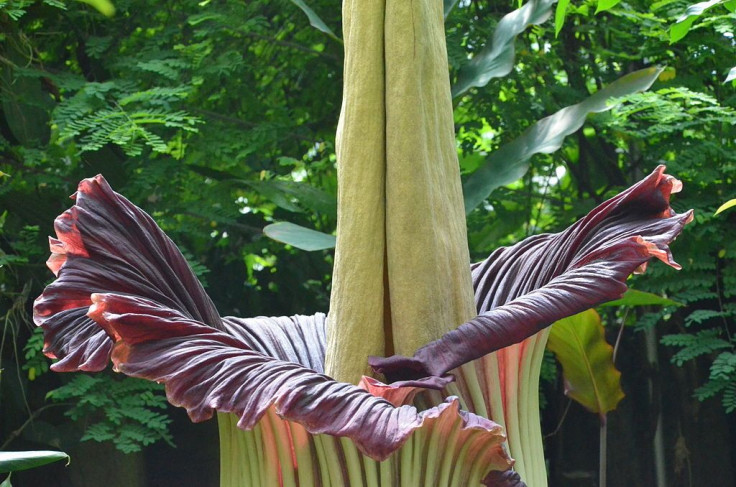Hundreds Line Up To See Rare Blooming Of Endangered, Foul-Smelling Corpse Flower
KEY POINTS
- The corpse flower is endemic to Sumatra, Indonesia
- It is also cultivated in botanical gardens worldwide
- Its signature flower spike reaches over three meters in height
- When it doesn't flower, it produces a single tree-like leaf
A massive corpse flower at a botanical garden in Warsaw has gone into one of its rare and short-lived blooms, and crowds of people have come to see it.
The endangered corpse flower (Amorphophallus titanium) rarely blooms. When it does, it blooms only for 24 to 48 hours, so it typically becomes a major tourist attraction.
Such was the case for the corpse flower that recently bloomed at the Warsaw University Botanical Garden, reported AP News. Hundreds of people lined up for hours from Sunday evening into Monday morning just to catch a glimpse of the rare event. By early Monday, the massive flower was already withering.
Warsaw University Botanical Garden has a livestream of the event, so those who would like to see it can do so without having to smell its signature foul smell that's been likened to that of rotting flesh.
Apart from being rare and short-lived, corpse flower blooms are also unpredictable. As such, it's easy to see why hundreds of people flocked to the botanical garden to catch a glimpse of it.
Endangered corpse flower
The Amorphophallus titanum is a flowering plant that's endemic to the hillsides of Sumatran rainforests in Indonesia. It is massive, with its signature inner flower spike reaching over three meters in height. In fact, it's said to have the largest unbranched inflorescence (cluster of flowers) of any plant.
During the years when it doesn't flower, it produces a single tree-like leaf that grows to 4.6 to 7 meters tall.
Outside of its endemic location, the corpse flower is also cultivated in botanical gardens worldwide, helping preserve the species. For instance, one can watch a timelapse of the 2018 corpse flower bloom event at the New York Botanical Garden. In the short clip, one can see just how fleeting each bloom truly is.
The first known blooming outside Sumatra was at London's Royal Botanical Gardens at Kew in 1889, AP News noted.
Unfortunately, this fascinating plant is already listed as endangered because of threats such as deforestation and land degradation. Its forest habitat in Sumatra has significantly declined since 1990, having been converted to plantations for oil palm, timber or paper.

© Copyright IBTimes 2024. All rights reserved.






















